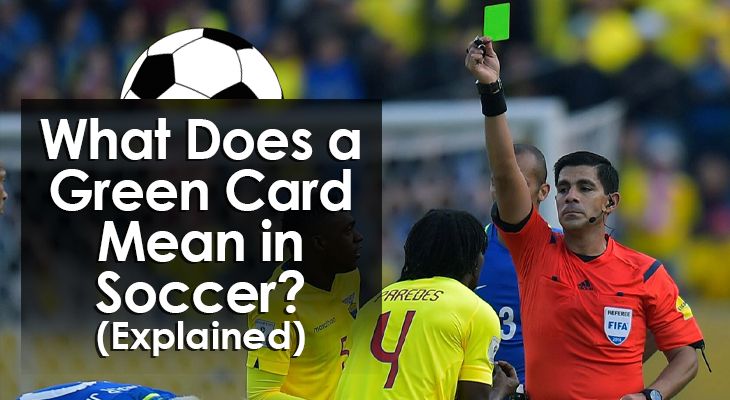What Is A Green Card In Soccer? (Explained)
When you hear the term "green card," soccer is probably not the first thing that comes to mind.
Soccer fans are more familiar with the cards that referees actually use during a game - the yellow and red cards.
Both cards are more known for their application in discipline, as referees use them to either give warnings or send a player off the pitch.
Referees may also use them for players and coaching staff that are not actually on the field of play.
There is one other card, however -- the green card.
It’s not nearly as popular or widely used as the other two, but the idea behind it has surfaced in different forms a couple of times in the past.
Let's take a closer look at soccer's green card, the background behind its adoption, and the various methods and use cases of the system.
How Did The Green Card Come To Be?
The initial purpose of the green card was for it to serve as a reward for players that showed a true sense of sportsmanship on the pitch.
This idea came about in 1986 by a soccer referee from Colombia named Roosevelt Castro Bohorquez.
According to Roosevelt, the idea came from the traffic lights yellow, red, and green.
Since the yellow and red cards existed as disciplinary measures, he believed there should be a green card for the other side of the game -- a reward system.
That year, Roosevelt created a manual for mutual respect in the game, and it was in this manual that the idea for a green card was first discussed.
He began to use them in children's soccer games to reward fair play and good behavior.
CONIFA and The Green Card
For context, we need to point out that there is a totally separate soccer federation from FIFA.
FIFA is the internationally recognized governing body for the sport, and they generally have their own set of rules and regulations.
However, there is also the “CONIFA” - the Confederation of Independent Football Associations.
This body serves as an association for the soccer teams that are NOT affiliated with FIFA.
These are usually teams from more obscure countries around the world with little impact on the game.
Formed in 2013, CONIFA currently has over 60 members, including teams from places such as:
- Northern Cyprus
- Sicily
- Yorkshire
- Tibet
- Western Papua
- Zanzibar
- Western Sahara
- Quebec
The association has its own rules and regulations -- most of which are standard.
However they do have a few exceptions, and the green card is one of those.
The idea behind CONIFA’s green card was to give the referees extra levels of control over the behavior of the players.
It was to create an avenue for punishing dissent, diving, and other infringements that may not be worthy of a regular red card.
Different from the originally intended purpose, see?

So, What Does The Green Card Do?
This is where things get a bit complicated.
There are up to three (3) variations when it comes to the use of the green card, and the two known use cases involved very different methods.
Use Case 1 - The Italian Serie B Way
The first time the green card was ever awarded was in an Italian Serie B game in 2016.
That year, Serie B clubs decided to adopt a reward system for players to boost fair play in the league, promising a reward for the player that ends the league season with the highest number of green cards.
Fast forward to the game between Vicenza Calcio and Virtus Entella later that season.
During the game, the referee wrongly awarded a corner kick to Vicenza Calcio.
Cristian Galano (a Vicenzo player) explained that the last person to touch the ball was actually his teammate.
The referee reversed the call and awarded the green card in his notes.
There was no physical card shown here.
The green card never really caught on in the league after that, and it's not in effect anymore.
It was not badly received, but it never really made a difference either and simply faded away.
Use Case 2 - The CONIFA Way
According to the rules of CONIFA, if a player receives a green card, that player must leave the field as they would for a red card.
The differences here are:
- A substitute may come in to replace the player if they still have free substitutes left.
- The player does not get suspended for any subsequent games.
A CONIFA World Cup happens every two years, and the first green card shown in one of their games was in the 2018 World Cup.
The game featured Padania and Tuvalu, with Padania winning 8-0.
Despite the scoreline, the most intriguing moment of the game was when the ref showed green cards to a player on each team for dissent.
Both players had to leave the pitch as their teams put in substitutes.
Highlights here:
The Irish FA Way
The Irish FA also adopts a green card reward system in some youth competitions.
There is a list of “rules'' that the players are to follow to qualify for the card, listed below:
- Line up & shake hands with the opposing team & game officials before and after each game.
- No over-aggressive play.
- No foul or abusive language from players or coaches.
- Players involved in a foul must shake hands before play restarts.
- No fighting
- Show respect to the officials, other players & coaches at all times.
Conclusion
Soccer is constantly evolving, and so are its rules.
The modern game is much more strict about fair play, and it looks like a good environment for the green card to shine.
The concept of the card and its various use cases is an interesting one.
Even though it has failed to kick off so far, it can still be adopted at some point in the future.
Until then, we’ll reserve further judgment and watch it all play out.
What do you think?

